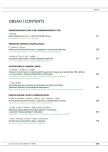-
Medical journals
- Career
Neurosarcoidosis: a Rare Case of Sarcoidosis of the Cervical Spinal Cord – Case Report
Authors: E. Kantorová 1; E. Kurča 1; J. De Riggo 2; J. Šutovský 2; J. Michalik 1; V. Nosáľ 1; E. Rozborilová 3; J. Hamžík 4; M. Hladká 5; J. Plank 6
Authors‘ workplace: Neurologická klinika JLF UK a MFN 1; Neurochirurgické oddelenie MFN 2; Klinika tuberkulózy a pľúcnych chorôb JLF UK a MFN 3; Chirurgická klinika JLF UK a MFN 4; Rádiodiagnostická klinika JLF UK a MFN 5; Ústav patologickej anatómie JLF UK a MFN 6
Published in: Cesk Slov Neurol N 2008; 71/104(5): 588-591
Category: Case Report
Overview
Sarcoidosis is a granulomatous disease whose aetiology is not precisely known. It most often affects the lungs and the lymph nodes, less frequently the eye, bone marrow, the central and peripheral nervous system, the kidneys, the liver, the heart and muscles. In terms of pathomorphology, it comprises a deposit of lymphocytes and mononuclear phagocyte cells surrounding the noncaseating epithelioid cells of the granulomas. The nervous system is damaged in 5–15% of cases of sarcoidosis. Sarcoidosis of the cervical spinal cord is rare and, according to the available data, accounts for 0.3–0.4% of cases. Establishing a diagnosis of neurosarcoidosis is not usually straightforward. The disease responds well to steroids, which may be used in combination with other immunosuppressive medicines. There is a favourable prognosis for survival but the resulting neurological condition depends on the location and size of the scar after the removal of the granulomatous inflammation. In this article the authors describe the case history of a patient with a probable to certain diagnosis of neurosarcoidosis of the cervical spinal cord.
Key words:
granulomatous disorders – sarcoidosis – medullar localisation of sarcoidosis
Sources
1. Hoitsma E, Faber CG, Drent M, Sharma OP. Neurosarcoidosis: a clinical dilemma. Lancet Neurol 2004; 3(7): 397–407.
2. Shetty AK, Gedalia A. Sarcoidosis: a pediatric perspective. Clin Pediatr (Phila) 1998; 37(12): 707–717.
3. Zajicek JP, Scolding NJ, Foster O, Rovaris M, Evanson J, Moseley IF et al. Central nervous system sarcoidosis – diagnosis and management. QJM 1999; 92(2): 103–117.
4. Zajicek JP. Neurosarcoidosis. Curr Opin Neurol 2000; 13(3): 323–325.
5. Toth C, Martin L, Morrish W, Coutts S, Parney I. Dramatic MRI improvement with refractory neurosarcoidosis treated with infliximab. Acta Neurol Scand 2007; 116(4): 259–262.
6. Sakuta M, Kumamoto T, Iizuka T, Nishiyama K, Oritsu M. Diagnostic criteria of neurosarcoidosis. No To Shinkei 2006; 58(6): 471–476.
7. Kolek V, Penicková V, Herman M, Gronych B,Houdek M. Neurosarcoidosis. Role of new examination methods for early diagnosis and therapy. Čas Lék česk 1996; 135(5): 141–144.
8. Patel AV, Stickler DE, Tyor WR. Neurosarcoidosis. Curr Treat Options Neurol 2007; 9(3): 161–168.
9. Caneparo D, Lucetti C, Nuti A, Cipriani G, Tessa C, Fazzi P et al. A case of sarcoidosis presenting as a non‑specific intramedullary lesion. Eur J Neurol 2007; 14(3): 346–349.
10. Stern BJ. Neurological complications of sarcoidosis. Curr Opin Neurol 2004; 17(3): 311–316.
11. Marangoni S, Argentiero V, Tavolato B. Neurosarcoidosis. Clinical description of 7 cases with a proposal for a new diagnostic strategy. J Neurol 2006; 253(4): 488–495.
12. Scott TF, Yandora K, Valeri A, Chieffe C,Schramke C. Aggressive therapy for neurosarcoidosis: long‑term follow‑up of 48 treated patients. Arch Neurol 2007; 64(5): 691–696.
Labels
Paediatric neurology Neurosurgery Neurology
Article was published inCzech and Slovak Neurology and Neurosurgery

2008 Issue 5-
All articles in this issue
- Neurological Disorders in Critical Illness
- Matrix Metalloproteinases in the Pathophysiology of Multiple Sclerosis
- Current Diagnostics and Therapy of Oligodendrogliomas
- The Importance of Brain Activity Monitoring with Integrated EEG Amplitude in Neonates with Early Asphyxia Syndrome
- Right-Lefthandedness and Crossed Foot Preference. Testing of Laterality and Cerebellar Dominance
- Traumatic Brain Injury and Fractures of the Facial Skeleton
- Radiosurgery of Craniopharyngeomas in Combination with Stereotactic Methods
- Combined Injury of the Atlas and Axis Vertebrae
- Spinal Cord Metastasis of Adenocarcinoma – Case Report
- Neurosarcoidosis: a Rare Case of Sarcoidosis of the Cervical Spinal Cord – Case Report
- Lumbar Intradural Disc Herniation Manifesting as Cauda Equina Syndrome – Case Report
- Gliomatosis Cerebri – Case Report
- Czech and Slovak Neurology and Neurosurgery
- Journal archive
- Current issue
- Online only
- About the journal
Most read in this issue- Lumbar Intradural Disc Herniation Manifesting as Cauda Equina Syndrome – Case Report
- Current Diagnostics and Therapy of Oligodendrogliomas
- Neurological Disorders in Critical Illness
- Neurosarcoidosis: a Rare Case of Sarcoidosis of the Cervical Spinal Cord – Case Report
Login#ADS_BOTTOM_SCRIPTS#Forgotten passwordEnter the email address that you registered with. We will send you instructions on how to set a new password.
- Career

